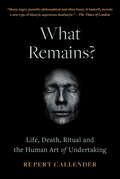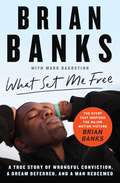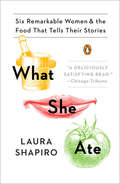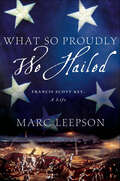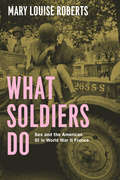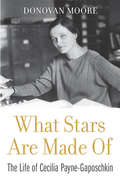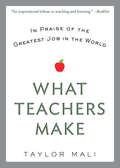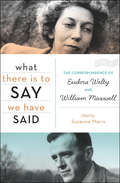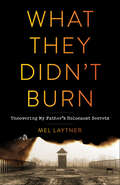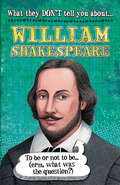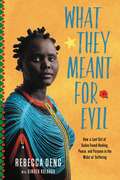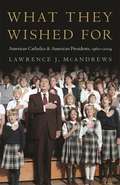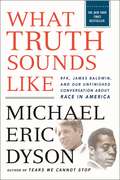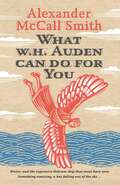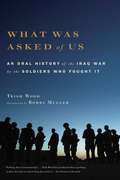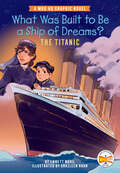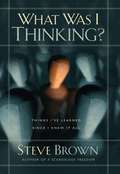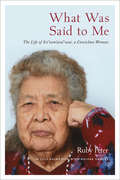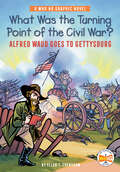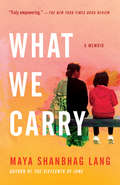- Table View
- List View
What Remains?: Life, Death and the Human Art of Undertaking
by Rupert Callender‘This book is a great work of craft and beauty.’ Salena Godden ‘This compelling personal story of a pioneering punk undertaker is a moving revelation.’ Love Reading ‘Inspiring and unforgettable.’ John Higgs, author of William Blake vs the World Death has shown me...the unbreakable core of love and courage that lies at the heart of what it means to be human. Ru Callender wanted to become a pioneering undertaker in order to offer people a more honest experience than the stilted formality of traditional ‘Victorian’ funerals. Driven by raw emotion and the unresolved grief of losing his own parents, Ru brought an outsider, ‘DIY’ ethos to the business of death, combined with the kinship and inspiration he found in rave culture, social outlaws and political nonconformists. Ru has carried coffins across windswept beaches, sat in pubs with caskets on beer-stained tables, helped children fire flaming arrows into their father’s funeral pyre, turned modern occult rituals into performance art and, with the band members of the KLF, is building the People’s Pyramid of bony bricks in Liverpool – all in the name of creating truly authentic experiences that celebrate those who are no longer here and those who remain. Radical, poignant, unflinchingly real and laugh-aloud funny, What Remains? will change the way you think about life, death and the human experience.
What Set Me Free (The Story That Inspired the Major Motion Picture Brian Banks): A True Story of Wrongful Conviction, a Dream Deferred, and a Man Redeemed
by Brian BanksBrian Banks, the major motion picture starring Aldis Hodge, Greg Kinnear, and Sherri Shepherd, winner of the audience award at the 2018 LA Film Festival, opens nationwide in 2019! Discover the unforgettable and inspiring true story of Brian Banks—a young man who was wrongfully convicted as a teenager and imprisoned for more than five years, only to emerge with his spirit unbroken and determined to achieve his dream of playing in the NFL.At age sixteen, Brian Banks was a nationally recruited All-American Football player, ranked eleventh in the nation as a linebacker. Before his seventeenth birthday, he was in jail, awaiting trial for a heinous crime he did not commit. Although Brian was innocent, his attorney advised him that as a young black man accused of rape, he stood no chance of winning his case at trial. Especially since he would be tried as an adult. Facing a possible sentence of forty-one years to life, Brian agreed to take a plea deal—and a judge sentenced him to six years in prison. At first, Brian was filled with fear, rage, and anger as he reflected on the direction his life had turned and the unjust system that had imprisoned him. Brian was surrounded in darkness, until he had epiphany that would change his life forever. From that moment on, Brian made the choice to shed the bitterness and anger he felt, and focus only on the things he had the power to control. He approached his remaining years in prison with a newfound resolve, studying and applying spirituality, improving his social and writing skills, and taking giant leaps on his journey toward enlightenment. When Brian emerged from prison with five years of parole still in front of him, he was determined to re-build his life and finally prove his innocence. Three months before his parole was set to expire, armed with a shocking recantation from his accuser and the help of the California Innocence Project, the truth about his unjust incarceration came out and he was exonerated. Finally free, Brian sought to recapture a dream once stripped away: to play for the NFL. And at age twenty-eight, he made that dream come true. Perfect for fans of Just Mercy, I Beat the Odds, and Infinite Hope, this powerful memoir is a deep dive into the injustices of the American justice system, a soul-stirring celebration of the resilience of the human spirit, and an inspiring call to hold fast to our dreams.
What She Ate: Six Remarkable Women and the Food That Tells Their Stories
by Laura Shapiro"A collection of deft portraits in which food supplies an added facet to the whole.”—Slate“Mouthwatering.”—Eater.com A beloved culinary historian’s short takes on six famous women through the lens of food and cooking—what they ate and how their attitudes toward food offer surprising new insights into their lives.Everyone eats, and food touches on every aspect of our lives—social and cultural, personal and political. Yet most biographers pay little attention to people’s attitudes toward food, as if the great and notable never bothered to think about what was on the plate in front of them. Once we ask how somebody relates to food, we find a whole world of different and provocative ways to understand her. Food stories can be as intimate and revealing as stories of love, work, or coming-of-age. Each of the six women in this entertaining group portrait was famous in her time, and most are still famous in ours; but until now, nobody has told their lives from the point of view of the kitchen and the table. It’s a lively and unpredictable array of women; what they have in common with one another (and us) is a powerful relationship with food. They include Dorothy Wordsworth, whose food story transforms our picture of the life she shared with her famous poet brother; Rosa Lewis, the Edwardian-era Cockney caterer who cooked her way up the social ladder; Eleanor Roosevelt, First Lady and rigorous protector of the worst cook in White House history; Eva Braun, Hitler’s mistress, who challenges our warm associations of food, family, and table; Barbara Pym, whose witty books upend a host of stereotypes about postwar British cuisine; and Helen Gurley Brown, the editor of Cosmopolitan, whose commitment to “having it all” meant having almost nothing on the plate except a supersized portion of diet gelatin.
What So Proudly We Hailed: Francis Scott Key, A Life
by Marc LeepsonWhat So Proudly We Hailed is the first full-length biography of Francis Scott Key in more than 75 years. In this fascinating look at early America, historian Marc Leepson explores the life and legacy of Francis Scott Key. Standing alongside Betsy Ross, Thomas Paine, Patrick Henry, Paul Revere, and John Hancock in history, Key made his mark as an American icon by one single and unforgettable act, writing "The Star-Spangled Banner." Among other things, Leepson reveals:• How the young Washington lawyer found himself in Baltimore Harbor on the night of September 13-14, 2014• The mysterious circumstances surrounding how the poem he wrote, first titled "The Defense of Ft. M'Henry," morphed into the National Anthem• Key's role in forming the American Colonization Society, and his decades-long fervent support for that controversial endeavor that sent free blacks to Africa• His adamant opposition to slave trafficking and his willingness to represent slaves and freed men and women for free in Washington's courts• Key's role as a confidant of President Andrew Jackson and his work in Jackson's "kitchen cabinet"• Key's controversial actions as U.S. Attorney during the first race riot in Washington, D.C., in 1835. Publishing to coincide with the 200th anniversary of "The Star Spangled Banner" in 2014, What So Proudly We Hailed reveals unexplored details of the life of an American patriot whose legacy has been largely unknown until now.
What Soldiers Do: Sex and the American GI in World War II France
by Mary Louise RobertsHow do you convince men to charge across heavily mined beaches into deadly machine-gun fire? Do you appeal to their bonds with their fellow soldiers, their patriotism, their desire to end tyranny and mass murder? Certainly—but if you’re the US Army in 1944, you also try another tack: you dangle the lure of beautiful French women, waiting just on the other side of the wire, ready to reward their liberators in oh so many ways. That’s not the picture of the Greatest Generation that we’ve been given, but it’s the one Mary Louise Roberts paints to devastating effect in What Soldiers Do. Drawing on an incredible range of sources, including news reports, propaganda and training materials, official planning documents, wartime diaries, and memoirs, Roberts tells the fascinating and troubling story of how the US military command systematically spread—and then exploited—the myth of French women as sexually experienced and available. The resulting chaos—ranging from flagrant public sex with prostitutes to outright rape and rampant venereal disease—horrified the war-weary and demoralized French population. The sexual predation, and the blithe response of the American military leadership, also caused serious friction between the two nations just as they were attempting to settle questions of long-term control over the liberated territories and the restoration of French sovereignty. While never denying the achievement of D-Day, or the bravery of the soldiers who took part, What Soldiers Do reminds us that history is always more useful—and more interesting—when it is most honest, and when it goes beyond the burnished beauty of nostalgia to grapple with the real lives and real mistakes of the people who lived it.
What Stars Are Made Of: The Life of Cecilia Payne-Gaposchkin
by Donovan MooreCecilia Payne-Gaposchkin was the revolutionary scientific thinker who discovered what stars are made of. But her name is hard to find alongside those of Hubble, Herschel, and other great astronomers. Donovan Moore tells the story of Payne-Gaposchkin’s life of determination against all the obstacles a patriarchal society erected against her.
What Teachers Make
by Taylor MaliIn praise of the greatest job in the world... The right book at the right time: an impassioned defense of teachers and why we need them now more than ever. Teacher turned teacher's advocate Taylor Mali inspired millions with his original poem "What Teachers Make," a passionate and unforgettable response to a rich man at a dinner party who sneeringly asked him what teachers make. Mali's sharp, funny, perceptive look at life in the classroom pays tribute to the joys of teaching...and explains why teachers are so vital to our society. What Teachers Make is a book that will be treasured and shared by every teacher in America--and everybody who's ever loved or learned from one.
What The Buddha Taught
by Walpola Sri RahulaScholar outlines Buddhist practice referring to writings from Chinese and Tibetan manuscripts not available in English translation.
What There Is to Say We Have Said: The Correspondence of Eudora Welty and William Maxwell
by Suzanne MarrsLetters revealing a lost literary world—and a unique friendship between a brilliant author and a New Yorker editor. For over fifty years, Eudora Welty and William Maxwell, two of our most admired writers, penned letters to each other. They shared their worries about work and family, literary opinions and scuttlebutt, and moments of despair and hilarity. Living half a continent apart, their friendship was nourished and maintained by their correspondence. What There Is to Say We Have Said bears witness to Welty and Maxwell&’s editorial relationship—both in Maxwell&’s capacity as New Yorker editor and in their collegial back-and-forth on their work. It&’s also a chronicle of the literary world of the time; they talk of James Thurber, William Shawn, Katherine Anne Porter, J. D. Salinger, Isak Dinesen, William Faulkner, John Updike, Virginia Woolf, Walker Percy, Ford Madox Ford, John Cheever, and many more. It is a treasure trove of reading recommendations. Here, Suzanne Marrs—Welty&’s biographer and friend—offers an unprecedented window into two intertwined lives. Through careful collection of more than three hundred letters as well as her own insightful introductions, she gives us &“a vivid snapshot of 20th-century intellectual life and an informative glimpse of the author-editor relationship, as well a tender portrait of devoted friendship&” (Kirkus Reviews).
What They Didn't Burn: Uncovering My Father's Holocaust Secrets
by Mel LaytnerWhat if you uncovered a Nazi paper trail that revealed your father to be a man very different from the quiet, introspective dad you knew . . . or thought you knew? Growing up, author Mel Laytner saw his father as a quintessential Type B: passive and conventional. As he uncovered documents the Nazis didn’t burn, however, another man emerged—a black market ringleader and wily camp survivor who made his own luck. The tattered papers also shed light on painful secrets his father took to his grave. Melding the intimacy of personal memoir with the rigors of investigative journalism, What They Didn’t Burn is a heartwarming, inspiring story of resilience and redemption. A story of how desperate survivors turned hopeful refugees rebuilt their shattered lives in America, all the while struggling with the lingering trauma that has impacted their children to this day.
What They Don't Tell You About: William Shakespeare
by Anita GaneriDid you know that Shakespeare couldn't spell his own surname? Love him or hate him, everyone has heard of the world's most famous playwright. But did the Elizabethans think he was a genius or simply that he wrote great soap operas? Any book on Shakespeare will give you the boring facts THEY think you should know, but only this one will tell you what the bard and his mates were REALLY like ... Uncover a wealth of information about Shakespeare! Find out where he was born and look at his family tree, see a map of Shakespeare's Stratford and Shakespeare's London, find out what school was like in Shakespeare's time, what London life was like and what sort of people went to the theatre. See a cross-section illustration of the Globe and discover how special effects were created and what actors wore. Read biographies of famous actors of the era such as Edward Alleyn, Richard Burbage, Richard Tarlton and William Kempe as well as biographies of contemporary writers Ben Jonson, Thomas Kyd and Christopher Marlowe. Read famous quotes and sayings and whizz your eye over a timeline of Shakespeare's plays and of his life. This book will tell you what Shakespeare's longest or shortest play is, or even which is the most miserable or goriest? It includes plots and information about ten of Shakespeare's plays: Richard III; Romeo and Juliet; A Midsummer Night's Dream; The Merchant of Venice; Henry V; Twelfth Night; Hamlet; Othello; Macbeth and The Tempest. It highlights some of Shakespeare's funniest characters and some of those that were in love. It concludes looking at how Shakespeare died, and discusses whether Shakespeare was, in fact, Sir Francis Bacon, Edward De Vere, Roger Manners, William Stanley or Christopher Marlowe. Finally, test your knowledge of all you've read with a fun 20-question quiz.
What They Meant for Evil: How a Lost Girl of Sudan Found Healing, Peace, and Purpose in the Midst of Suffering
by Rebecca DengMany stories have been told about the famous Lost Boys, but now for the first time, a Lost Girl shares her hauntingly beautiful and inspiring story. One of the first unaccompanied refugee children to enter the United States in 2000, after South Sudan's second civil war took the lives of most of her family, Rebecca's story begins in the late 1980s when, at the age of four, her village was attacked and she had to escape. WHAT THEY MEANT FOR EVIL is the account of that unimaginable journey. With the candor and purity of a child, Rebecca recalls how she endured fleeing from gunfire, suffering through hunger and strength-sapping illnesses, dodging life-threatening predators-lions, snakes, crocodiles, and soldiers alike-that dogged her footsteps, and grappling with a war that stole her childhood. Her story is a lyrical, captivating portrait of a child hurled into wartime, and how through divine intervention, she came to America and found a new life full of joy, hope, and redemption.
What They Never Told Us: True Stories of Family Secrets and Hidden Identities Revealed
by Gail LukasikFrom acclaimed bestselling author of White Like Her: My Family's Story of Race and Racial Passing, comes a brand new collection of stories of people uncovering their past.What They Never Told Us tells the stories of ordinary people who made extraordinary, life-changing discoveries about their parentage and/or race and ethnicity that fractured their identities. The book asks the big questions: Who are we? And what is family? Blending social history and personal narratives, each story delves into the devastating psychological trauma of uncovering a hidden family secret with all the twists and turns of a mystery novel from how the discovery was made; to why it was kept secret; to the arduous, sometimes disappointing, quest to find the biological parent or parents. To fully understand the secrecy surrounding these family secrets, the book examines pre-WWII and post-WWII attitudes toward infertility, adoption, donor conception, race and racial passing, and unmarried pregnant women. Prefacing these harrowing narratives is the author's own confusing and sometimes painful journey to redefine her racial identity under the spotlight of public opinion. Searingly raw and honest, What They Never Told Us tells the stories that were never meant to be heard.
What They Wished For: American Catholics and American Presidents, 1960-2004
by Lawrence J. McandrewsRoman Catholics constitute the most populous religious denomination in the United States, comprising one in four Americans. With the election of John F. Kennedy as president in 1960, they attained a political prominence to match their rapidly ascending socioeconomic and cultural profile. From Vietnam to Iraq, the civil rights movement to federal funding for faith-based initiatives, and from birth control to abortion, Catholics have won at least as often as they have lost. What They Wished For by Lawrence J. McAndrews traces the role of American Catholics in presidential policies and politics from 1960 until 2004. Though divided by race, class, gender, and party, Catholics have influenced issues of war and peace, social justice, and life and death among modern presidents in a profound way, starting with the election of President Kennedy and expanding their influence through the intervening years with subsequent presidents. McAndrews shows that American Catholics, led by their bishops and in some cases their pope, have been remarkably successful in shaping the political dialogue and at helping to effect policy outcomes inside and outside of Washington. Indeed, although they opened this era by helping to elect one of their own, Catholic voters have gained so much influence and have become so secure in their socioeconomic status--and so confident in their political standing--that they closed the era by rejecting one of their own, voting for George W. Bush over John Kerry in 2004.
What To Do About Alice?: How Alice Roosevelt Broke the Rules, Charmed the World, and Drove Her Father Teddy Crazy!
by Barbara Kerley Edwin FotheringhamA witty and stylish biography of a maverick American heroine -- the outspoken, irresistible daughter of Teddy Roosevelt. Theodore Roosevelt had a small problem. Her name was Alice. Alice Lee Roosevelt was hungry to go places, meet people, do things! Father called it running riot. Alice called it eating up the world. Whether she was entertaining important White House visitors with her pet snake or traveling the globe, Alice bucked convention and turned every new experience into an adventure! Brimming with affection and wit, this spirited biography gives readers a peek at family life inside the White House. Prose and pictures spring, gambol, and two-step across the pages to celebrate a maverick American heroine.
What Truth Sounds Like: Robert F. Kennedy, James Baldwin, and Our Unfinished Conversation About Race in America
by Michael Eric DysonNamed a 2018 Notable Work of Nonfiction by The Washington PostNOW A NEW YORK TIMES BESTSELLER • Winner, The 2018 Southern Book PrizeNAMED A BEST/MOST ANTICIPATED BOOK OF 2018 BY: Chicago Tribune • Time • Publisher's WeeklyA stunning follow up to New York Times bestseller Tears We Cannot StopThe Washington Post: "Passionately written."Chris Matthews, MSNBC: "A beautifully written book."Shaun King: “I kid you not–I think it’s the most important book I’ve read all year...” Harry Belafonte: “Dyson has finally written the book I always wanted to read...a tour de force.”Joy-Ann Reid: A work of searing prose and seminal brilliance... Dyson takes that once in a lifetime conversation between black excellence and pain and the white heroic narrative, and drives it right into the heart of our current politics and culture, leaving the reader reeling and reckoning."Robin D. G. Kelley: “Dyson masterfully refracts our present racial conflagration... he reminds us that Black artists and intellectuals bear an awesome responsibility to speak truth to power." President Barack Obama: "Everybody who speaks after Michael Eric Dyson pales in comparison.”In 2015 BLM activist Julius Jones confronted Presidential candidate Hillary Clinton with an urgent query: “What in your heart has changed that’s going to change the direction of this country?” “I don’t believe you just change hearts,” she protested. “I believe you change laws.”The fraught conflict between conscience and politics – between morality and power – in addressing race hardly began with Clinton. An electrifying and traumatic encounter in the sixties crystallized these furious disputes.In 1963 Attorney General Robert Kennedy sought out James Baldwin to explain the rage that threatened to engulf black America. Baldwin brought along some friends, including playwright Lorraine Hansberry, psychologist Kenneth Clark, and a valiant activist, Jerome Smith. It was Smith’s relentless, unfiltered fury that set Kennedy on his heels, reducing him to sullen silence.Kennedy walked away from the nearly three-hour meeting angry – that the black folk assembled didn’t understand politics, and that they weren’t as easy to talk to as Martin Luther King. But especially that they were more interested in witness than policy. But Kennedy’s anger quickly gave way to empathy, especially for Smith. “I guess if I were in his shoes…I might feel differently about this country.” Kennedy set about changing policy – the meeting having transformed his thinking in fundamental ways.There was more: every big argument about race that persists to this day got a hearing in that room. Smith declaring that he’d never fight for his country given its racist tendencies, and Kennedy being appalled at such lack of patriotism, tracks the disdain for black dissent in our own time. His belief that black folk were ungrateful for the Kennedys’ efforts to make things better shows up in our day as the charge that black folk wallow in the politics of ingratitude and victimhood. The contributions of black queer folk to racial progress still cause a stir. BLM has been accused of harboring a covert queer agenda. The immigrant experience, like that of Kennedy – versus the racial experience of Baldwin – is a cudgel to excoriate black folk for lacking hustle and ingenuity. The questioning of whether folk who are interracially partnered can authentically communicate black interests persists. And we grapple still with the responsibility of black intellectuals and artists to bring about social change.What Truth Sounds Like exists at the tense intersection of the conflict between politics and prophecy – of whether we embrace political resolution or moral redemption to fix our fractured racial landscape. The future of race and democracy hang in the balance.
What W. H. Auden Can Do for You (Writers on Writers #5)
by Alexander McCall SmithBestselling novelist Alexander McCall Smith's charming account of how the poet W. H. Auden has helped guide his life—and how he might guide yours, tooWhen facing a moral dilemma, Isabel Dalhousie—Edinburgh philosopher, amateur detective, and title character of a series of novels by best-selling author Alexander McCall Smith—often refers to the great twentieth-century poet W. H. Auden. This is no accident: McCall Smith has long been fascinated by Auden. Indeed, the novelist, best known for his No. 1 Ladies Detective Agency series, calls the poet not only the greatest literary discovery of his life but also the best of guides on how to live. In this book, McCall Smith has written a charming personal account about what Auden has done for him—and what he just might do for you.Part self-portrait, part literary appreciation, the book tells how McCall Smith first came across the poet's work in the 1970s, while teaching law in Belfast, a violently divided city where Auden's "September 1, 1939," a poem about the outbreak of World War II, strongly resonated. McCall Smith goes on to reveal how his life has related to and been inspired by other Auden poems ever since. For example, he describes how he has found an invaluable reflection on life's transience in "As I Walked Out One Evening," while "The More Loving One" has provided an instructive meditation on unrequited love. McCall Smith shows how Auden can speak to us throughout life, suggesting how, despite difficulties and change, we can celebrate understanding, acceptance, and love for others.An enchanting story about how art can help us live, this book will appeal to McCall Smith's fans and anyone curious about Auden.
What Was Asked of Us: An Oral History of the Iraq War by the Soldiers Who Fought It
by Trish Wood Bobby Muller"A visceral account of the war ... honest, agenda-free, and chilling." - New York Times Book Review. The Iraq war officially began on March 20, 2003, and since then more than one million young Americans have rotated through the country's insurgent-infested hot spots. But although stories of dramatic ambushes and attacks dominate the front pages of newspapers, most of us do not truly know what the war is like for the Americans who fight it. What Was Asked of Us helps us bridge that gap.The in-depth and intensely probing interviews this book brings together document the soldiers' experiences and darkest secrets, offering a multitude of authentic, unfiltered voices - at times raw and emotional, at other times eloquent and lyrical. These voices walk us through the war, from the successful push to Baghdad, through the erroneous "Mission Accomplished" moment, and into the dangerous, murky present. "Monumental ... Amid the glut of policy debates, and amid the flurry of news reports that add names each day to the lists of the dead, Trish Wood has produced what is perhaps, to date, the only text about Iraq that matter."- San Francisco Chronicle. "An illuminating glimpse of American fighters' experiences in Iraq ... There are moments of strange beauty in the soldiers' recollections." - Chicago Tribune. "Stunning ... chillingly eloquent ... Powerful and unflinchingly honest, Wood's book deserves to be a bestseller." -People.
What Was Built to Be a Ship of Dreams?: A Who HQ Graphic Novel (Who HQ Graphic Novels)
by Who HQ Emmett NahilDiscover the story of the Titanic&’s ill-fated voyage through three diverse perspectives of survivors in this affecting graphic novel by Let Me Out author Emmett Nahil and award-winning illustrator Shazleen Khan.Presenting Who HQ Graphic Novels: an exciting addition to the #1 New York Times bestselling Who Was? series!Follow the journeys of Syrian Lebanese siblings Jamilah and Ilyas Yarred, the Haitian French Laroche family, and American socialite Margaret Brown as history&’s most famous ship heads toward disaster. A story of class disparity, family, and survival, this graphic novel immerses readers in the different experiences that passengers from varying backgrounds faced before, during, and after the Titanic&’s sinking. This gripping narrative is brought to life by atmospheric full-color illustrations that will transport readers to that fateful wreck.
What Was I Thinking?: Things I've Learned Since I Knew It All
by Steve BrownSeminary professor, radio broadcaster, and former pastor Steve Brown is tired. He confesses, "I'm tired of glib answers to hard questions, irrelevant 'God words' and stark, cold foundations on which no house has ever been built." So he set out to revitalize his faith by reexamining his thoughts and his faith. And he shares his invigorating discoveries with readers. A potent tonic for those whose faith feels flat, What Was I Thinking? fully engages the heart, mind, and soul.
What Was Said to Me: The Life of Sti’tum’atul’wut, a Cowichan Woman
by Ruby Peter Helene DemersA narrative of resistance and resilience spanning seven decades in the life of a tireless advocate for Indigenous language preservation. Life histories are a form of contemporary social history and convey important messages about identity, cosmology, social behaviour and one's place in the world. This first-person oral history—the first of its kind ever published by the Royal BC Museum—documents a period of profound social change through the lens of Sti'tum'atul'wut—also known as Mrs. Ruby Peter—a Cowichan elder who made it her life's work to share and safeguard the ancient language of her people: Hul'q'umi'num'. Over seven decades, Sti'tum'atul'wut mentored hundreds of students and teachers and helped thousands of people to develop a basic knowledge of the Hul'q'umi'num' language. She contributed to dictionaries and grammars, and helped assemble a valuable corpus of stories, sound and video files—with more than 10,000 pages of texts from Hul'q'umi'num' speakers—that has been described as "a treasure of linguistic and cultural knowledge." Without her passion, commitment and expertise, this rich legacy of material would not exist for future generations
What Was the Harlem Renaissance? (What Was?)
by Sherri L. Smith Who HQIn this book from the #1 New York Times bestselling series, learn how this vibrant Black neighborhood in upper Manhattan became home to the leading Black writers, artists, and musicians of the 1920s and 1930s.Travel back in time to the 1920s and 1930s to the sounds of jazz in nightclubs and the 24-hours-a-day bustle of the famous Black neighborhood of Harlem in uptown Manhattan. It was a dazzling time when there was an outpouring of the arts of African Americans--the poetry of Langston Hughes; the novels of Zora Neale Hurston; the sculptures of Augusta Savage and that brand-new music called jazz as only Duke Ellington and Louis Armstrong could play it. Author Sherri Smith traces Harlem's history all the way to its seventeenth-century roots, and explains how the early-twentieth-century Great Migration brought African Americans from the deep South to New York City and gave birth to the golden years of the Harlem Renaissance.With 80 fun black-and-white illustrations and an engaging 16-page photo insert, readers will be excited to read this latest addition to Who HQ!
What Was the Turning Point of the Civil War?: A Who HQ Graphic Novel (Who HQ Graphic Novels)
by Who HQ Ellen T. Crenshaw"A nuanced piece of history told simply and well." — Kirkus ReviewsDiscover the story behind the Battle of Gettysburg through the eyes of war reporter Alfred Waud in this compelling graphic novel -- written and illustrated by National Book Award-longlisted creator Ellen T. Crenshaw.Presenting Who HQ Graphic Novels: an exciting new addition to the #1 New York Times Best-Selling Who Was? series!See the Battle of Gettysburg through the eyes Alfred Waud, a special artist and war correspondent whose depiction of Pickett's Charge is thought to be the only visual account by an eyewitness. A story of extreme risk, strife, and the search for truth, this graphic novel invites readers to immerse themselves into the crucial Civil War battle -- brought to life by gripping narrative and vivid full-color illustrations that jump off the page.
What We Carry: A Memoir
by Maya Shanbhag Lang&“A gorgeous memoir about mothers, daughters, and the tenacity of the love that grows between what is said and what is left unspoken.&”—Mira Jacob, author of Good Talk If our family stories shape us, what happens when we learn those stories were never true? Who do we become when we shed our illusions about the past? Maya Shanbhag Lang grew up idolizing her brilliant mother, an accomplished physician who immigrated to the United States from India and completed her residency all while raising her children and keeping a traditional Indian home. Maya&’s mother had always been a source of support—until Maya became a mother herself. Then the parent who had once been so capable and attentive became suddenly and inexplicably unavailable. Struggling to understand this abrupt change while raising her own young child, Maya searches for answers and soon learns that her mother is living with Alzheimer&’s. Unable to remember or keep track of the stories she once told her daughter—stories about her life in India, why she immigrated, and her experience of motherhood—Maya&’s mother divulges secrets about her past that force Maya to reexamine their relationship. It becomes clear that Maya never really knew her mother, despite their close bond. Absorbing, moving, and raw, What We Carry is a memoir about mothers and daughters, lies and truths, receiving and giving care, and how we cannot grow up until we fully understand the people who raised us. It is a beautiful examination of the weight we shoulder as women and an exploration of how to finally set our burdens down.
What We Didn't Expect: Personal Stories about Premature Birth
by Melody SchreiberEvery year, 400,000 families in the United States welcome premature babies ...Ten percent of babies born in the U.S. are preemies. But that one word, "preemie," encompasses a range of medical and cultural experiences. There are textbooks, medical-ish guidebooks, and the occasional memoir to turn to ... but no book that collects personal experiences from the many people who have parented, cared for, or been preemies themselves. Until now. In What We Didn't Expect, journalist Melody Schreiber brings together a chorus of acclaimed writers and thinkers to share their diverse stories of having or being premature babies. The stories here cover everything from life-changing tests of faith to navigating the red tape of healthcare bureuacracy; from overcoming unimaginable grief to surviving and thriving against all odds. The result is a moving, heartfelt book, and a crucial and informative resource for anyone who has, or is about to have, the experience of dealing with a premature birth.
